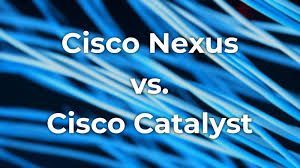
In the world of networking, Cisco stands as a giant, offering a wide range of switches tailored to different use cases and industries. Among their most notable product lines are the Catalyst and Nexus switches. While both are exceptional in their own right, understanding their differences can help you choose the right switch for your specific needs. Let’s dive into the key distinctions, use cases, and decision-making factors to help you make an informed choice.
Cisco Catalyst Switches: The Backbone of Enterprise Networks
Cisco Catalyst switches are designed primarily for enterprise environments, offering robust features and flexibility for campus networks. They excel in handling traditional Layer 2 and Layer 3 networking while incorporating advanced capabilities to support modern IT demands.
Key Features of Cisco Catalyst Switches:
High Port Density: Ideal for large campus networks with a need for multiple access and aggregation layers.
Advanced Security: Features like TrustSec, MACsec, and extensive ACL options ensure a secure network environment.
Wireless Integration: Seamlessly integrates with Cisco’s wireless solutions, making it a preferred choice for converged wired-wireless networks.
Automation and Analytics: Supports tools like Cisco DNA Center for intent-based networking, automation, and enhanced visibility.
Flexibility: Available in various models—from fixed configurations to modular designs—catering to different scalability needs.
When to Choose Catalyst Switches:
You’re building or upgrading a campus network.
You require extensive wireless support and integration.
Security and ease of management are top priorities.
You need switches optimized for end-user access and aggregation.
Cisco Nexus Switches: Built for Data Centers
Cisco Nexus switches are engineered for data center environments, focusing on high performance, low latency, and scalability. They support modern data center architectures like fabric networks, virtualization, and hybrid cloud environments.
Key Features of Cisco Nexus Switches:
High Throughput and Low Latency: Designed to handle massive data loads with minimal delay, perfect for data-intensive applications.
Data Center Technologies: Supports features like VXLAN, EVPN, and Cisco ACI for efficient and scalable data center operations.
Programmability: Equipped with APIs and tools for automation using Python, Ansible, and other frameworks.
Support for Storage Networking: Includes Fibre Channel over Ethernet (FCoE) capabilities for storage traffic.
High Availability: Redundant power supplies, fans, and advanced failover mechanisms ensure uninterrupted operation.
When to Choose Nexus Switches:
You’re building or expanding a data center.
Low latency and high throughput are critical.
You require advanced data center technologies like VXLAN or Cisco ACI.
Storage traffic integration is a priority.
Factors to Consider When Choosing
Network Environment:
Choose Catalyst switches for campus networks with a focus on user access, wireless integration, and security.
Opt for Nexus switches for data centers requiring high performance and support for advanced technologies like VXLAN.
Scalability and Performance:
Budget:
Catalyst switches are generally more cost-effective for enterprises.
Nexus switches, with their advanced features, come at a premium but deliver unmatched performance for data centers.
Management Tools:
Result:
Choosing between Cisco Catalyst and Nexus switches depends on your specific needs. If you’re focused on building a robust and secure enterprise campus network, Catalyst switches are your go-to option. On the other hand, if you’re managing a high-performance data center with advanced features like VXLAN and ACI, Nexus switches are the clear choice.
By understanding the strengths of each product line and aligning them with your organizational goals, you can make the best investment in your network infrastructure.
